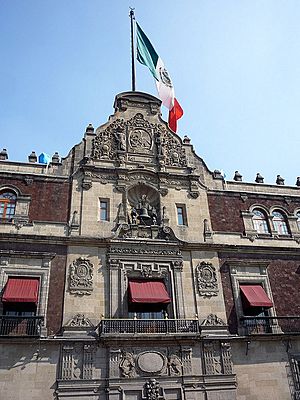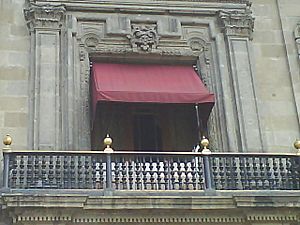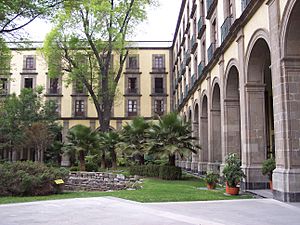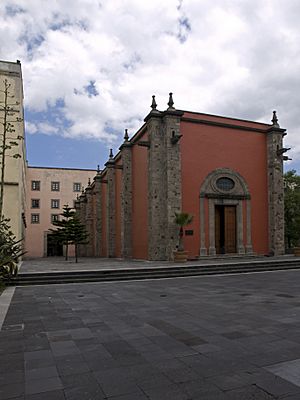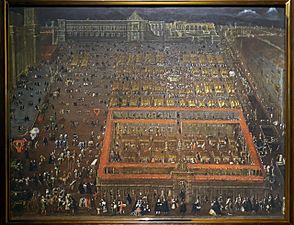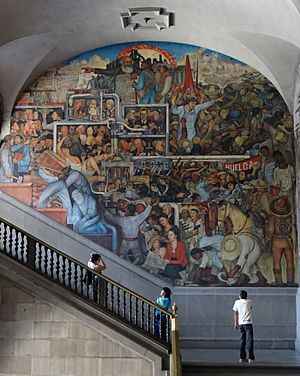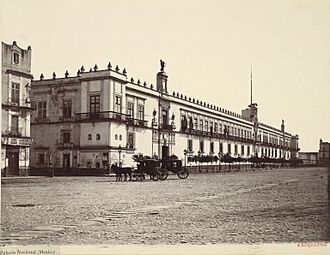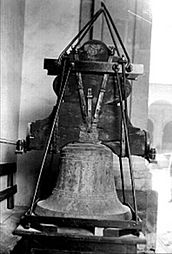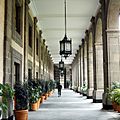National Palace (Mexico) facts for kids
Quick facts for kids National Palace |
|
|---|---|
|
Palacio Nacional (Spanish)
|
|

The National Palace in Mexico City
|
|
| Former names | Palace of the Viceroy Palacio Imperial |
| General information | |
| Architectural style | Baroque |
| Location | Mexico City, Mexico |
| Construction started | 1522 |
The National Palace (Spanish: Palacio Nacional) is a very important building in Mexico City, Mexico. It's where the country's government leaders work. Since 2018, it has also been the official home for the President of Mexico. You can find it on Mexico City's main square, called the Plaza de la Constitución, or El Zócalo. This spot has been a palace for Mexico's rulers since the time of the Aztec Empire. Many parts of the current palace are built from the original palace of the Aztec leader Moctezuma II from the 1500s.
Contents
Exploring the National Palace
The National Palace is a huge government building. It has a red stone front, called tezontle, and takes up the entire east side of the Zócalo. It's more than 200 meters (about 650 feet) long! Inside, you'll find offices for the country's treasury and the National Archives.
The front of the palace has three main doors and two towers on each side. Each door leads to a different part of the building. The southern door goes to the President's offices, which are not open to the public. The northern door is called the Mariana Door. This area used to be a prison and courtrooms, but now it holds offices for the Finance Ministry.
Above the middle door, facing the Zócalo, is a special balcony. Every year on September 15, just before 11 pm, the President of Mexico stands here. They give the Grito de Dolores, a famous speech to celebrate Mexican Independence. During this ceremony, the President rings a bell hanging above the balcony. This bell is the same one that Father Miguel Hidalgo rang in 1810 to start the fight for independence from Spain. It was moved here from its original church.
The central door leads to a large main courtyard with beautiful arches. Here, you can see amazing murals by a famous artist named Diego Rivera. These murals cover the main stairwell and walls of the second floor. They tell the story of Mexico from 1521 to 1930.
Rivera painted these murals between 1929 and 1935. They are like a giant comic book showing "The Epic of the Mexican People." One part shows Mexico before the Spanish arrived, focusing on the Aztec god Quetzalcóatl. He appears as a star, a god, and a human, teaching the Aztec people. This part shows the continuous cycle of life. Rivera wanted to show the importance of Mexico's indigenous roots.
The middle part of the mural shows the Spanish Conquest. It depicts both the difficult parts, like battles, and also priests who tried to protect the native people. Higher up, it shows Mexico's fight for independence. Below that, you can see parts of later wars and the Mexican Revolution. The left side of the mural shows Mexico in the early to mid-1900s. It includes important figures and even Diego's wife, Frida Kahlo. These murals share Diego's personal views on Mexico's history and its people.
Diego Rivera also painted other murals on the middle floor. These show scenes from the pre-Hispanic era, like markets and the arrival of Hernán Cortés in Veracruz. He started a series about different ancient Mexican peoples, but it was never finished.
On the top floor, there used to be a fancy theater room for the viceroys. Later, it became the meeting place for the Chamber of Deputies (like a parliament) from 1829 until a fire destroyed it in 1872. Important documents like the Constitution of 1857 and the Constitution of 1917 are displayed here.
The palace has many courtyards, but only a few are open to visitors. It also holds the main State Archives, with many old historical documents. There's also the Biblioteca Miguel Lerdo de Tejada, one of Mexico's biggest libraries.
In the northern part of the building, you'll find the Benito Juárez Museum. This museum is dedicated to Benito Juárez, a very important former president of Mexico. You can see his bedroom, living room, and study, with many of his personal items. There's also a statue of Juárez by Miguel Noreña.
History of the Building
Moctezuma's "New Houses"
The National Palace stands on the same spot where Moctezuma II had his "New Houses" palace. This was a grand home for the Aztec emperor and also where he conducted official business. It was beautifully decorated with marble and colorful paintings. The palace had gardens, fountains, and even special rooms for solving problems among the people. When Hernán Cortés saw it, he was very impressed. After the Spanish Conquest, Moctezuma's palace was mostly destroyed.
Cortés's Palace
Hernán Cortés claimed the land and buildings for himself. He had a new palace built there between 1521 and 1530. Cortés's palace was like a strong fortress, with places for cannons and guards. It had large courtyards and a big garden. The main courtyard was even big enough for the first bullfights in New Spain! In 1562, the Spanish king bought the palace from Cortés's family.
Viceregal Palace
After the Spanish Crown bought the palace, it became known as the Palacio del Virrey (Palace of the Viceroy). The viceroy was the ruler sent by the King of Spain. This palace was not just the viceroy's home, but also held many government offices, courts, and even small prisons.
The palace faced some challenges. In 1624 and 1692, it was damaged by fires during times of unrest. After the 1692 fire, the palace was rebuilt. It lost its fortress-like look and gained a more elegant Baroque style. New windows with iron grilles were added. The palace remained largely the same until Mexico gained independence.
-
Views of the Alameda and the Palace of the Viceroys of Mexico (before the 1711 reconstruction), around 1676.
After Independence
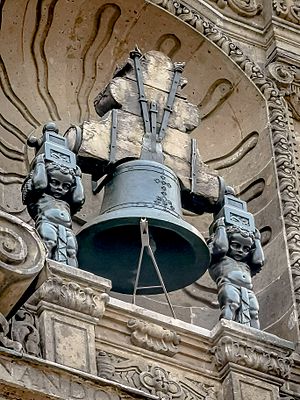
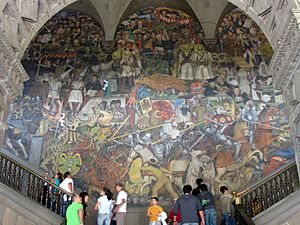
After Mexico became independent in the 1820s, the palace was renamed the "National Palace." Many of Mexico's new government offices were set up here. Over the years, different leaders made changes to the building. For example, in 1850, the northern door was built.
In 1864, Maximilian of Habsburg, who was an emperor of Mexico for a short time, added three flagpoles in front of the main doors. He also had a grand marble staircase built. Later, in 1896, the famous bell that Father Hidalgo rang was moved to the palace.
Between 1926 and 1929, a third floor was added to the palace. The building's front was covered with red tezontle stone, giving it the look it has today. The Dolores Bell was placed in a special spot above the central balcony. Inside, a large marble staircase was installed in the central patio, which is where Diego Rivera later painted his famous murals.
Palace as Presidential Residence
Many important leaders have lived in the National Palace. Most of the Spanish viceroys lived here. After independence, two emperors of Mexico, Agustin de Iturbide and Maximilian I of Mexico, also lived in the palace. Mexico's first president, Guadalupe Victoria, was the first president to live there.
For many years, presidents lived elsewhere, like Chapultepec Castle. However, in 2018, President Andrés Manuel López Obrador decided to make the National Palace the official presidential residence once again. Famous people like Sor Juana Inés de la Cruz and Alexander von Humboldt have also stayed here.
Archaeological Discoveries
Over the years, work on the palace's foundation has led to exciting discoveries. Workers found old column bases from the Viceroy Palace. They also found ancient cedar wood beams that were part of the first floor's foundation.
Recently, during renovations, parts of Moctezuma's "New Houses" have been unearthed. These include pieces of a wall and a stone floor. These discoveries are believed to be from a special room called Casa Denegrida, or the Black House. Spanish explorers described it as a dark room where Moctezuma would go to think and meditate. It was part of a larger complex that included offices, living quarters, and even a zoo! More excavations are planned to learn more about this ancient Aztec palace.
Why the Palace is Important

The National Palace is a symbol of Mexico's long history. It shows how Spanish and Aztec cultures blended together. The old Aztec palace was destroyed, but the new Spanish palace was built using many of the same stones. This represents how Mexico is a mix of both cultures.
This building has seen all of Mexico's major historical events. It has stood strong through different rulers and changes. On the night before Mexican Independence Day, the National Palace is the center of attention. The President gives the famous Grito de Dolores from its balcony, ringing Father Hidalgo's original bell. It's a place where Mexico celebrates its past and welcomes friends from around the world.
The Palace Cats
Did you know that the National Palace has its own resident cats? Feral cats have lived in the palace gardens since the 1970s. As of 2024, there are 19 cats living there! In April 2024, President Andres Manuel López Obrador made a special declaration. He called the cats "living fixed assets." This means the government must provide them with food and care for their entire lives. It's the first time animals in Mexico have been given such a title! One cat, named Zeus, even became famous for appearing on TV during a press conference with the President in 2023.
Gallery
-
A mural by Diego Rivera
-
A portrait of Agustín de Iturbide
-
The El Grito ceremony in 2023
See also
 In Spanish: Palacio Nacional (México) para niños
In Spanish: Palacio Nacional (México) para niños



